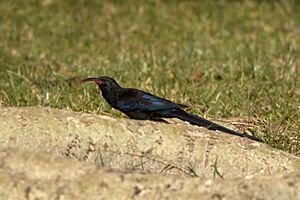Black-billed wood hoopoe facts for kids
Quick facts for kids Black-billed wood hoopoe |
|
|---|---|
 |
|
| A Black-billed Wood-hoopoe in Bishangari Lodge, Ethiopia | |
| Conservation status | |
| Scientific classification | |
| Genus: |
Phoeniculus
|
| Species: |
somaliensis
|
The black-billed wood hoopoe (Phoeniculus somaliensis) is a special type of bird. It belongs to a family of birds called Phoeniculidae. This bird lives in eastern Africa. You can usually find it in areas with lots of trees and bushes.
Contents
Discover the Black-billed Wood Hoopoe
What Does This Bird Look Like?
The black-billed wood hoopoe looks very much like its relative, the green wood hoopoe. However, there are a few key differences! This bird does not have a green shine on its head or back. Also, its beak is black, not red. Sometimes, the black beak might have a small reddish spot near its base.
Both male and female black-billed wood hoopoes look alike. An adult bird is about 37 centimeters (14.5 inches) long. Their feathers are mostly black. They have a beautiful blue or purple shine. When they fly, you can see white spots on their flight feathers. These spots create a white bar across their wings. Their long tail also has white spots along its edges.
Where Do Black-billed Wood Hoopoes Live?
You can find the black-billed wood hoopoe in eastern Africa. Its home range includes countries like Djibouti, Eritrea, Ethiopia, Kenya, Somalia, Sudan, and South Sudan. They live in places up to about 2,000 meters (6,560 feet) high.
These birds prefer living in woodlands and bushy areas. They also like the edges of forests. You might spot them near rivers in "gallery forests." They often live among large trees, like Acacias, that grow in dry riverbeds called wadis.
What Do Black-billed Wood Hoopoes Eat?
The black-billed wood hoopoe loves to eat small creatures. Its diet includes arthropods, which are like insects and spiders. It also eats millipedes, beetles, and other invertebrates. These are animals without a backbone.
They find their food by moving along tree trunks and branches. They often creep along the bark, sometimes even upside-down! They use their beaks to poke into cracks and crevices to find hidden snacks.
How Is the Black-billed Wood Hoopoe Doing?
The black-billed wood hoopoe is a common bird. It lives across a very large area. Scientists have not measured if its numbers are going up or down. However, its population might be getting smaller. This is because the large trees where they build their nests are becoming rarer. People are cutting down these trees.
There are no other major threats known for this bird. The International Union for Conservation of Nature (IUCN) has looked at its situation. They have decided that its conservation status is "least concern." This means they are not currently worried about this bird becoming endangered.


